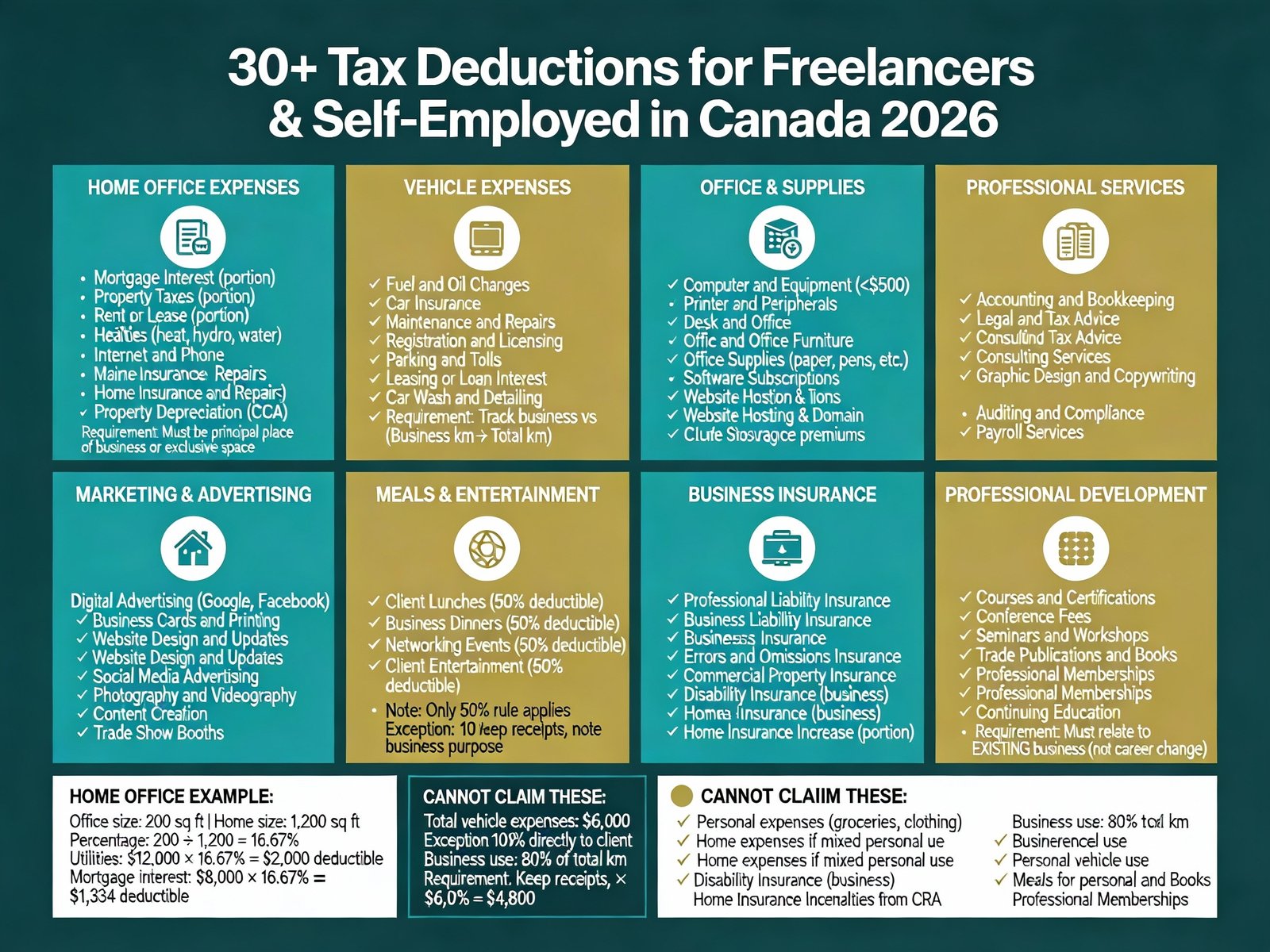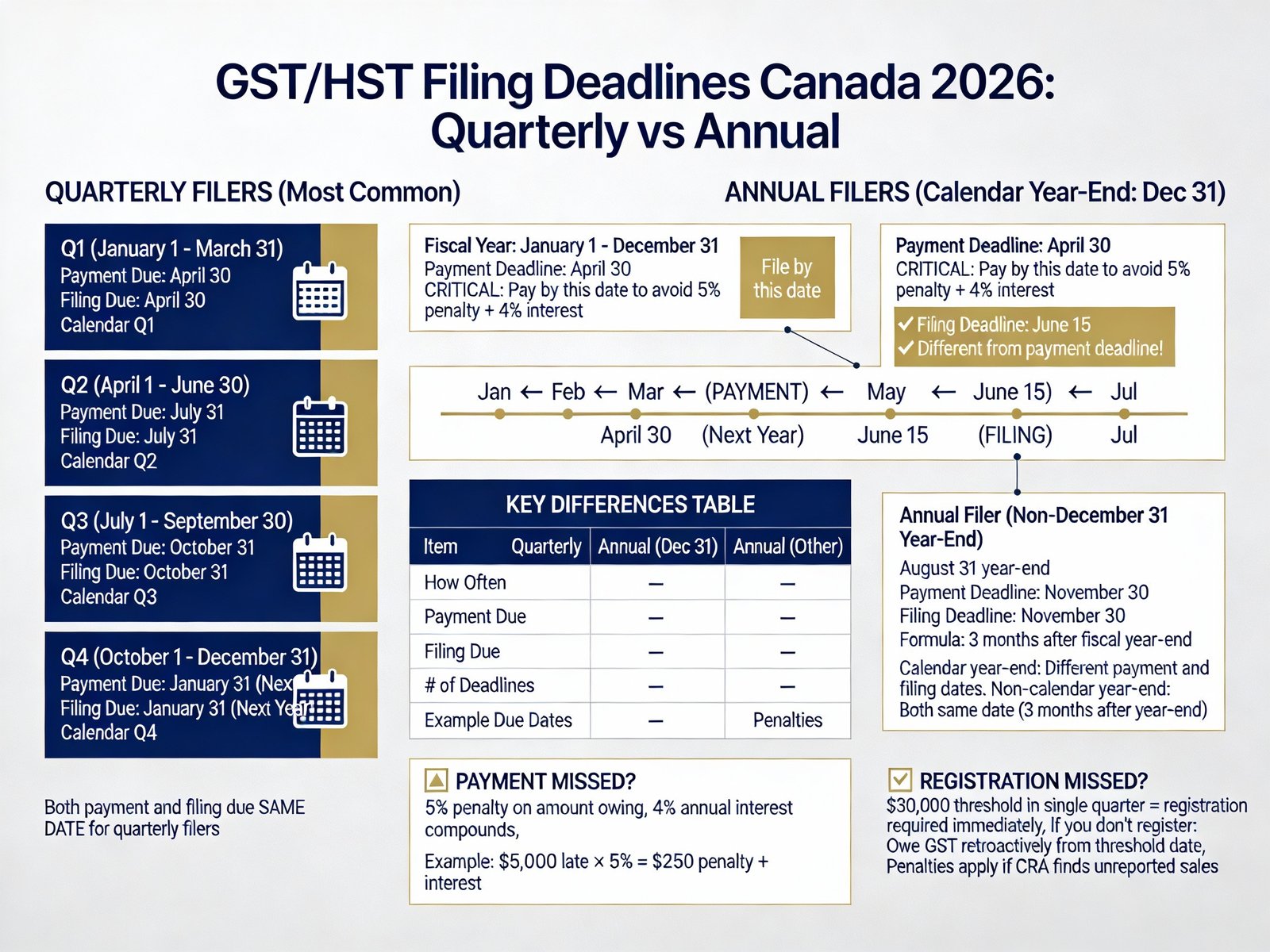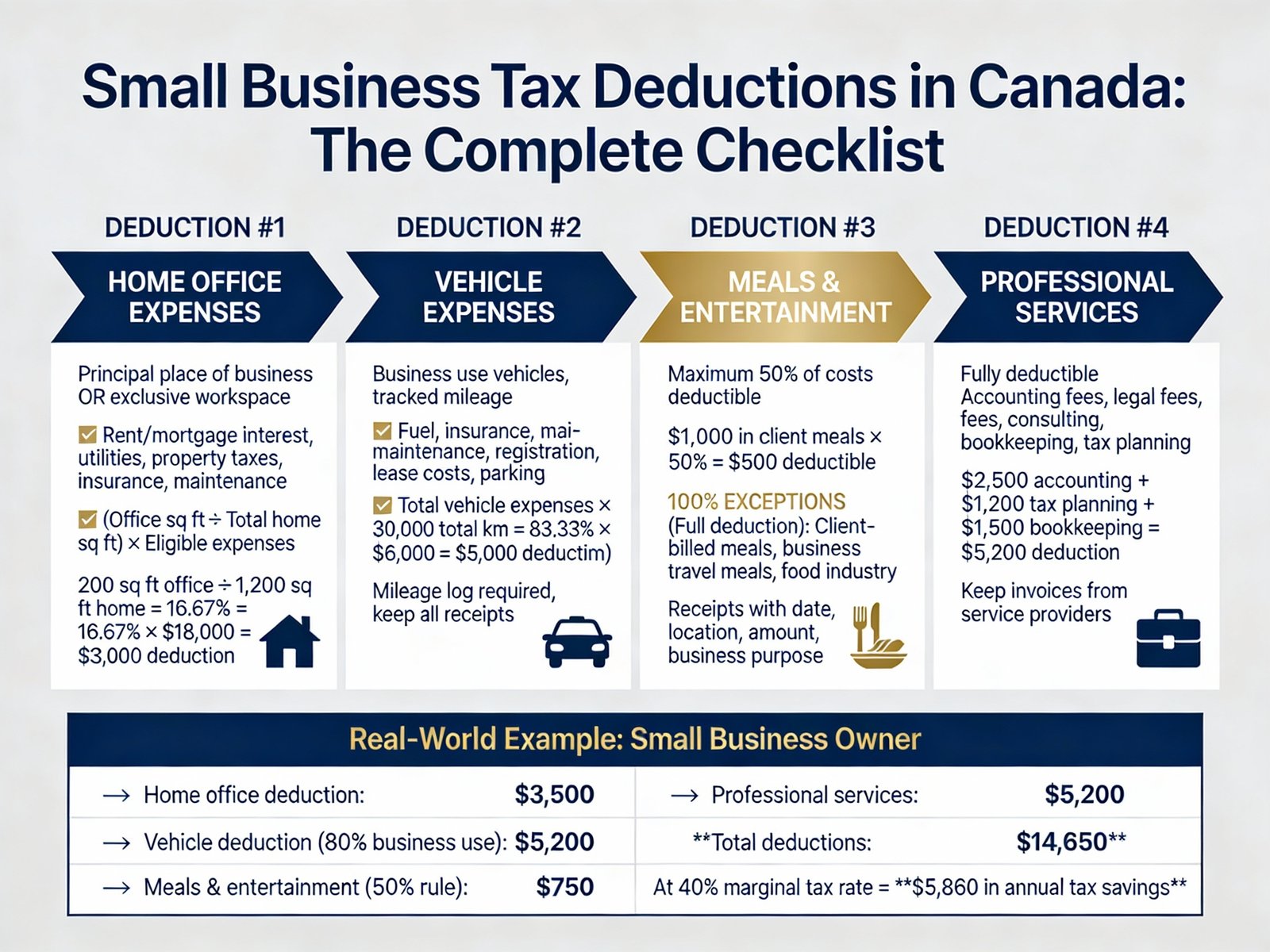Few things can disrupt your business operations quite like a CRA audit. The financial impact can be immediate and severe—a simple mistake like filing your return late triggers a 5% penalty plus 1% interest for every month of delay, up to 12 months. If the Canada Revenue Agency determines you’ve been grossly negligent, perhaps by providing false information or understating tax obligations, penalties can reach 50% of the tax payable.
Most Canadian taxpayers follow tax laws properly, but understanding what catches the CRA’s attention is crucial for protecting your business. The agency doesn’t select files randomly—they use risk assessment systems to identify potential problems. Certain patterns almost guarantee scrutiny. Businesses that consistently report losses to offset other income can expect examination. Large or unusual business expense claims frequently trigger reviews, as do businesses showing high revenue but surprisingly low taxable income.
Forbes Advisor Canada explains what warning signs might put your business under the CRA’s microscope. We’ll also cover how far back the agency can audit your records, what happens during the audit process, and most importantly, how you can prepare to minimize your risk. Understanding these factors isn’t just about staying compliant—it’s about protecting your business from potentially devastating financial consequences.
How CRA Selects Businesses for Audit
Understanding the CRA’s selection process can help you stay prepared and compliant. The Canada Revenue Agency doesn’t simply pick companies at random—they use sophisticated methods to identify potential non-compliance.
Risk-Based Selection Process
The CRA relies primarily on risk assessment systems to identify tax returns with potential issues. These systems analyze multiple factors, including the likelihood of errors and indicators of non-compliance with tax obligations. When a return is flagged as high-risk, a CRA officer reviews information from various sources to determine whether an audit is necessary.
Most audits aren’t random. The CRA uses advanced data analytics to detect patterns such as significant discrepancies between reported income and third-party information, unusual claim filings, or sudden changes in financial behavior. The agency cross-references data from financial institutions, property transactions, and employment records to identify inconsistencies that warrant further review.
The CRA’s analytics systems assign risk scores to taxpayers based on multiple variables, including:
- Previous audit history
- Error rates in tax returns
- Complexity of reported transactions
- Consistency with similar businesses
Businesses with higher risk scores face greater likelihood of selection for audit, ensuring the department effectively allocates resources toward cases with the greatest potential for non-compliance.
Common Red Flags in Tax Returns
Certain patterns and discrepancies in tax returns frequently trigger CRA scrutiny. Income that doesn’t match CRA records from T4A, T5 slips, or bank deposits ranks among the most common triggers. This mismatch is especially prevalent in cash-heavy businesses like restaurants, bars, and construction companies.
Claiming excessive or disproportionate business expenses relative to the income generated often prompts an audit. The CRA pays particular attention to deductions that are significantly higher than industry norms, especially in areas like travel, meals, or entertainment without proper documentation.
Reporting consecutive years of losses while continuing to operate is another significant trigger. The CRA may question whether your business is legitimate or merely a hobby. Similarly, if your lifestyle—homes, cars, vacations—doesn’t align with your declared income, the CRA may suspect unreported income.
Other common audit triggers include:
- Large or unusual cash transactions
- Inconsistent GST/HST reporting
- Related-party transactions between family members or connected businesses
- Businesses with high revenue but low reported taxable income
- Perfect round-off amounts for several expense items
The CRA often uses alternative methods to verify income, particularly when standard documentation seems inadequate. One such approach is the “indirect verification of income,” which includes the net worth method—comparing changes in assets, liabilities, and personal spending against reported income.
How Far Back Can CRA Audit Business Records?
Generally, the CRA has authority to audit a tax return within three years from the date of the initial assessment notice—known as the “normal reassessment period”. For individual taxpayers and Canadian-controlled private corporations (CCPCs), this typically means returns filed within the last three years. For non-CCPCs, this period extends to four years.
There are important exceptions to this timeframe. When the CRA suspects fraud or intentional misrepresentation, there is no time limit on how far back they can audit. If there’s evidence of carelessness, neglect, or willful default in tax filings, the CRA can extend beyond the standard reassessment period.
Other circumstances that may extend the audit period include:
- Voluntary payments made toward a tax debt
- Debts arising from tax shelters
- Inadequate reporting of foreign income or assets
For practical purposes, tax professionals generally recommend keeping your business records for at least six to seven years. This timeframe provides adequate protection against most audit scenarios while ensuring you can substantiate your claims if selected for review.
Contact BOMCAS Canada today for all your Business income tax audits to ensure your documentation meets CRA standards and minimize your risk of facing penalties.
What Triggers a CRA Audit?
Specific patterns in your business tax filings can put you directly in the CRA’s crosshairs. While the agency uses sophisticated risk assessment systems, certain red flags almost guarantee closer scrutiny of your business operations.
Unusual Business Expense Claims
Business expense claims that seem disproportionately high compared to industry standards or your reported income draw immediate attention. The CRA specifically looks for:
- Writing off luxury travel, high-end meals, or personal expenses as business costs without proper justification
- Claiming excessive vehicle expenses that don’t align with actual business use
- Reporting home office deductions that seem unreasonable for your business type
- Deducting entertainment costs that exceed industry norms
Claiming significant deductions in categories like advertising, marketing, meals, travel, and miscellaneous expenses essentially places a “look harder at this” flag on your tax return. Auditors are trained to spot when business expenses seem unreasonable or don’t match the nature of your operations.
Frequent Losses Reported
Consistently reporting business losses over multiple years will almost certainly attract CRA attention. While legitimate losses occur, the agency becomes suspicious when a business continually operates at a loss while remaining active.
The tax authority specifically watches for these patterns:
- Businesses reporting losses for three or more consecutive years
- Using these losses to offset other income sources
- Continuing operations despite no clear path to profitability
To qualify as a legitimate business in the CRA’s view, there must be a reasonable expectation of profit. If your business continuously operates at a loss, the CRA might determine you’re running a hobby rather than a legitimate profit-seeking venture.
Large Cash Transactions
Businesses handling substantial cash operations face heightened scrutiny. Under Canadian law, transactions involving CAD 13,933.60 or more in cash must be reported to FINTRAC within 15 calendar days. The “24-hour rule” requires reporting when you receive two or more cash amounts totaling CAD 13,933.60 or more within a consecutive 24-hour period.
Industries most vulnerable to cash-transaction audits include:
- Restaurants and bars
- Retail businesses
- Construction and renovation contractors
- Personal service providers
The CRA recognizes that cash-intensive businesses have greater opportunities to underreport income, making them prime targets for examination.
Income Not Matching Lifestyle
One of the most obvious audit triggers occurs when your reported income doesn’t support your standard of living. The CRA actively correlates taxpayers’ reported income with their lifestyle, including real estate costs and maintenance.
Common lifestyle-income mismatches that trigger audits include:
- Reporting low income while living in an expensive home
- Owning high-value assets inconsistent with declared income
- Making large cash deposits or showing unexplained financial activity
When using the net worth method to verify income, CRA auditors examine changes in assets, liabilities, personal spending, and other relevant information such as gifts or inheritances. This approach allows them to identify discrepancies between your tax filings and actual financial situation.
Related-Party Transactions
Transactions between related parties, including family members or connected businesses, receive extra scrutiny during CRA reviews. The tax authority specifically watches for:
- Overpaying spouses and children for services rendered to the business
- Transactions that appear designed primarily for tax avoidance
- Non-arm’s length property rentals below market value
- Corporate loans to shareholders that might disguise personal expenses
These transactions must be properly documented and reflect fair market value to avoid penalties during an audit.
Understanding these triggers can help you maintain proper compliance and reduce your risk of facing a CRA business audit.
Understanding the CRA audit process
When you’re facing a CRA business audit, knowing what to expect can significantly reduce anxiety and help you respond effectively. The Canada Revenue Agency follows specific procedures that become much less intimidating once you understand them.
Initial contact and audit notice
The audit process typically begins when a CRA auditor contacts you by phone, mail, or both. If you receive an unexpected call, you might question whether the caller is legitimate. You can end the call and contact the auditor or team leader back after verifying their credentials. You can also wait for the official audit confirmation letter before providing any additional information.
This confirmation letter serves as formal notification and contains essential details about your audit. You’ll find information about the specific tax years under review, required documentation, questions the CRA wants answered, and deadlines for submission.
Read the letter carefully—it often provides clear insights into what the CRA is investigating, which helps you plan your response appropriately. First impressions matter. Submitting a well-organized package of documents demonstrates professionalism and can streamline the entire process.
On-site vs. office audits
CRA business audits generally fall into two main categories, each with distinct characteristics.
On-site audits take place at your business location, residence, or representative’s office. These allow auditors to examine your operations firsthand and address questions quickly, often minimizing delays in completing the audit. The auditor will present valid identification upon arrival before beginning the examination.
Office audits occur at a CRA location and are typically reserved for simpler cases or those focused on specific items. These reviews are usually less detailed than field audits but more thorough than correspondence audits. Sometimes the CRA centralizes audit management in particular offices, meaning you might be assigned an auditor from outside your region.
Regardless of location, auditors may need to make copies of electronic records or borrow physical documents, providing detailed receipts for any borrowed materials.
CRA audit letter: what to expect
The audit letter contains specific information about document requirements and preparation. Auditors typically examine three categories of records: business records like ledgers, journals, invoices, receipts, contracts, and bank statements; personal records of business owners including personal bank statements, mortgage documents, and credit card statements; and records of individuals or entities related to the business such as spouses, family members, corporations, or partnerships.
After you submit your documents, the auditor reviews them to determine whether adjustments are necessary. If changes are proposed, you’ll receive a proposal letter outlining the CRA’s findings. This document isn’t final—you typically have 30 days to contest it through additional submissions with substantive legal arguments and supporting documentation.
The audit concludes in one of two ways: either no changes are made to your original tax filings, or the CRA adjusts your returns, potentially resulting in additional taxes owed. If adjustments are made, you’ll receive a Notice of Reassessment, which you can dispute by filing a Notice of Objection within 90 days.
Maintaining open communication with your auditor throughout this process is crucial. Responding promptly to requests and organizing your records meticulously can significantly impact the outcome.
What Documents CRA Can Request
The scope of documents the Canada Revenue Agency can legally demand during a business audit often catches business owners off guard. The agency’s authority extends far beyond basic tax returns and financial statements.
Business Records and Ledgers
Your core business documentation forms the foundation of any tax audit. CRA auditors have the authority to examine comprehensive business records including:
- Ledgers and journals documenting your financial transactions
- Sales invoices, purchase invoices, and cash register receipts
- Formal contracts and work orders
- Bank statements and deposit slips
- Cheques and credit card receipts
- Tax returns and supporting documentation
The CRA requires businesses to maintain source documents that substantiate all financial transactions. These source documents serve as the primary evidence validating your tax reporting and must be organized to establish clear audit trails from supporting documentation to your summarized financial accounts.
If you conduct e-commerce transactions, web logs, email confirmations, digital invoices, and security measures like digital signatures become crucial components of your audit trail. For businesses operating under electronic data interchange agreements, all electronic records including functional acknowledgments must be preserved.
Personal Financial Documents
CRA auditors can demand personal financial information from business owners. This authority extends to:
- Personal bank account statements
- Mortgage documents and property records
- Credit card statements from personal accounts
- Investment and asset documentation
The examination of personal financial records primarily serves to verify whether your reported income aligns with your lifestyle and personal spending patterns. Since business owners sometimes mix personal and business finances, these documents help auditors establish a complete financial picture.
Third-Party Records (e.g., Family, Partners)
Perhaps most surprisingly, the CRA possesses broad powers to request information about the audited taxpayer from third parties. This authority encompasses:
- Personal or business records of spouses and family members
- Documents from business partners and related entities
- Records from corporations, partnerships, or trusts connected to the business owner
Under subsection 231.2 of the Income Tax Act, the CRA can compel third parties to provide documents related to the administration or enforcement of tax laws. This power is often exercised when auditors suspect undeclared income or questionable transactions between related parties.
The CRA is not required to notify the taxpayer under audit when seeking information from external sources. Auditors may obtain bank statements or other documentation directly from financial institutions if they suspect unreported income or if you no longer have such records.
Digital Records and Cloud Data
Proper electronic record keeping is essential in today’s digital business environment. The CRA stipulates that all business records in electronically readable format must be retained. This requirement encompasses:
- Electronic accounting systems and software
- Cloud-based financial records
- Email communications relevant to tax purposes
- Digital invoices and receipts
When original source documents exist in electronic format, they must remain in an electronically readable format even if transferred to another medium such as microfilm. Additionally, documentation describing your operating and business systems must be maintained and provided upon request.
Outsourcing your record keeping to third parties such as bookkeepers, accountants, or cloud service providers does not relieve you of your record keeping responsibilities. You remain accountable for ensuring all electronic records remain accessible and readable for CRA audit purposes.
Contact BOMCAS Canada today for all your Business income tax audits to ensure your documentation meets CRA standards and avoid potential penalties resulting from inadequate record keeping.
What happens if CRA audits you
The audit is over—now what? Understanding the possible outcomes helps you prepare for what comes next and know your options if you disagree with the results.
Audit findings and reassessment
Once the audit wraps up, you’ll receive a written summary of the CRA’s findings. This leads to one of three scenarios. If no problems are found, the audit simply closes with no changes to your previous assessment. If issues are discovered, you’ll face additional tax owing through a reassessment notice. The auditor may give you an estimate of what you owe before the official notice arrives, allowing you to pay immediately and avoid accumulating interest charges. In some cases, the assessment could work in your favor, leading to a tax reduction and refund.
You have 30 days to respond if changes are proposed. During this time, you can either accept the findings or challenge them by providing additional documentation or explanations.
CRA audit penalties and interest
Additional tax isn’t the only concern—penalties can substantially increase your financial burden. Large corporations must pay 50% of any disputed amount immediately upon filing a notice of objection, regardless of whether they agree with the assessment.
Interest continues accumulating on outstanding amounts even during disputes. This means you might face significant interest charges on the initially assessed amount, even if you eventually win your case.
Penalty severity depends on the nature of the problem. When the CRA determines there was misrepresentation due to “neglect, carelessness, willful default, or fraud,” they can reassess your return at any time, regardless of the normal reassessment period. This removes the time limitation that would otherwise protect older tax years from examination.
Options if you disagree with the outcome
If you receive a reassessment you disagree with, you have several options. Start by trying to resolve the disagreement directly with the auditor. If that doesn’t work, escalate to the auditor’s team leader.
For formal disputes, you must file a Notice of Objection within 90 days of receiving your Notice of Reassessment. This objection should clearly explain why you disagree and include all relevant documentation and supporting arguments. The objection represents the first formal step in resolving a tax dispute.
Collection action on disputed amounts is typically postponed for 90 days after the CRA sends its decision. However, there are exceptions—taxes you were required to withhold and remit must still be paid, as must 50% of disputed amounts for large corporations or charitable donation tax credits related to tax shelters.
If the CRA’s Appeals division upholds the reassessment and you still disagree, you can appeal to the Tax Court of Canada within 90 days of receiving the notice of confirmation. This begins a more formal legal process that may require professional representation.
Contact BOMCAS Canada today for all your Business income tax audits to ensure you handle the post-audit process successfully and minimize potential financial impacts on your business.
Your Rights and Responsibilities During an Audit
Understanding your rights as a taxpayer provides essential protection during a CRA business audit. The balance between what you’re entitled to and what you’re required to do shapes both your experience and the potential outcome.
Taxpayer Bill of Rights
The Taxpayer Bill of Rights establishes 16 fundamental protections when dealing with the CRA. These rights ensure the agency serves you with accuracy, professionalism, courtesy, and fairness. Several rights prove particularly important during business audits:
- The right to pay no more and no less than required by law
- The right to privacy and confidentiality regarding your information
- The right to formal review and subsequent appeal
- The right to professional, courteous, and fair treatment
- The right not to pay disputed income tax amounts before an impartial review
- The right to have the law applied consistently
- The right to be represented by a person of your choice
These protections help ensure the CRA conducts audits within proper boundaries. If you believe the agency hasn’t respected these rights, you can file a service complaint.
Your Responsibility to Provide Records
Along with your rights come specific legal obligations during a CRA business audit. You must maintain adequate books and records to determine your tax obligations and entitlements. These records typically must be kept for a minimum of six years.
For electronic business transactions, you’re responsible for preserving information generated during transaction processing, such as web logs or email confirmations, and security measures that maintain record authenticity, like electronic signatures. This requirement applies even when you use third-party services for these transactions.
Your responsibilities extend to making all records available when requested and providing reasonable assistance to auditors. This includes ensuring you or your representative is present during examinations, answering questions about your business operations, allowing officials to make copies of necessary records, and keeping your books in an electronically readable format.
Failing to provide required books and records constitutes an offense under tax law.
What CRA Cannot Ask For
Despite broad audit powers, the CRA faces certain limitations. The Supreme Court of Canada established that once the CRA’s “predominant purpose” shifts from determining correct tax to establishing penal liability, they must relinquish their inspection and requirement powers.
Auditors need explicit permission to enter a dwelling-house that serves as a place of business. Without consent, this requires a search warrant.
The CRA also cannot compel you to self-audit. Following the Federal Court of Appeal decision in BP Canada, the CRA cannot force taxpayers to self-audit on an ongoing basis and then use that information against them.
Understanding both your rights and responsibilities helps you approach a CRA business audit with confidence rather than fear.
How to reduce your audit risk
Proactive compliance offers your best protection against costly CRA business audits. The good news? Specific preventative measures can dramatically reduce your scrutiny risk while preparing your business to handle examination if selected.
Keep clean and organized records
Maintaining meticulous records serves as your primary defense against audit complications. Canadian law requires you to keep adequate books and records to determine your tax obligations for a minimum of six years from the end of the last tax year they relate to. This requirement covers both paper and electronic formats.
For electronic records, tax law mandates that you maintain your books in an electronically readable format, even if you also keep paper copies. This applies to all accounting software records, cloud-based financial data, and digital receipts.
When long-term acquisitions and disposal of property records, share registry information, or other historical documentation could affect a potential business sale or wind-up, you must keep these records indefinitely.
Avoid aggressive tax strategies
The Canada Revenue Agency actively uses the General Anti-Avoidance Rule (GAAR) to distinguish legitimate tax planning from abusive tax avoidance. Tax strategies promising extraordinary benefits often attract unwanted attention.
The CRA has increased audits of tax promoters and advisors who market questionable schemes. Those participating in or promoting these arrangements may face serious penalties, court-imposed fines, and potentially jail time.
Question any tax strategy that seems unusually beneficial—particularly tax shelter donations offering multiple deductions beyond your contribution amount. If a tax strategy seems too good to be true, it likely violates either the letter or spirit of tax law.
Use professional tax services
Professional tax assistance provides both expertise and protection. Consider implementing these professional-guided practices:
- Conduct quarterly compliance audits to verify tax documentation and identify risks before CRA inquiries
- Implement annual reconciliation processes ensuring tax filings align with financial disclosures
- Develop a structured CRA response playbook for managing audit requests strategically
- Pre-assign specific roles within your finance team for CRA interactions
Professionals can help ensure consistency between your reported income and lifestyle—a key factor the CRA examines when selecting audit targets. They can also assist in establishing cloud-based accounting systems that maintain accurate income and expense tracking.
Contact BOMCAS Canada today for all your Business income tax audits to ensure your records meet CRA standards and your tax positions are properly documented before an audit arises.
Preparing for a CRA business audit
Preparation for a CRA business audit starts well before you receive that official audit letter. Taking proactive steps not only makes the process smoother but can significantly improve your outcome.
Conduct internal reviews
Regular internal reviews serve as your first line of defense against audit complications. Annual self-audits help identify and fix potential issues before they catch the CRA’s attention. These reviews allow you to:
- Catch errors in expense classifications
- Verify reported revenue matches bank deposits
- Check for missing invoices or duplicate deductions
- Ensure GST/HST is correctly applied and remitted
Monthly or quarterly financial checks give you opportunities to cross-reference entries against bank statements and source documents. Focus particularly on remittance calculations, deduction accuracy, and benefits administration during these reviews.
Train staff on compliance
Effective staff training dramatically reduces your audit vulnerability. When payroll staff understand tax regulations properly, the likelihood of errors decreases substantially.
Staff education needs to extend beyond accounting personnel. All employees should understand proper documentation requirements for expense claims and reimbursements. Clear communication with employees about their wages, deductions, and benefits is crucial for maintaining transparency that reduces the likelihood of disputes during an audit.
Consult a tax advisor
Before any CRA contact occurs, establishing a relationship with a qualified tax professional provides crucial support. Upon receiving an audit notice, immediately contact your tax specialist to arrange qualified representation during the audit.
Meeting with a tax professional helps you understand the details and rationale behind each figure in your returns. Your advisor can accompany you to meetings and help communicate effectively with the CRA—particularly important given that anything said during initial audit interviews can be scrutinized later.
Your advisor should act as your spokesperson, representing your company professionally. This cooperation typically creates a more favorable environment that may lead to better interpretation of significant issues. Contact BOMCAS Canada today for all your Business income tax audits to ensure professional representation throughout this challenging process.
Conclusion
Understanding what triggers a CRA business audit gives you the power to protect your business before problems arise. The agency’s risk assessment systems target specific patterns—businesses showing lifestyle-income mismatches, claiming unusual expenses, or reporting consecutive losses face the highest scrutiny. This isn’t random selection; it’s calculated targeting based on red flags in your filings.
The audit process follows predictable stages, from initial contact through document review to final assessment. Knowing what to expect removes much of the intimidation factor. Your rights under the Taxpayer Bill of Rights protect you throughout this process, but you also have clear responsibilities for maintaining adequate records and providing reasonable cooperation.
Preparation remains your strongest defense. Keeping organized records for at least six years, avoiding questionable tax strategies, and conducting regular internal reviews can significantly improve your position if selected for examination. Professional guidance helps ensure your tax positions are properly documented and your business practices align with CRA expectations.
The financial consequences of a CRA audit are too severe to ignore. Penalties can reach 50% of tax payable for gross negligence, while interest continues accumulating even during disputes. But businesses that understand these warning signs and implement proper safeguards can navigate tax compliance with confidence. While no strategy eliminates audit risk entirely, being prepared makes all the difference in protecting your business from potentially devastating financial consequences.
Key Takeaways
Understanding CRA audit triggers and preparation strategies can protect your business from devastating financial consequences and ensure smoother compliance processes.
• CRA uses risk-based selection, not random audits – Advanced analytics identify patterns like income-lifestyle mismatches, consecutive losses, and excessive expense claims relative to industry norms.
• Maintain organized records for minimum 6 years – Keep both electronic and paper documentation accessible, including business ledgers, personal financial records, and third-party transaction evidence.
• Avoid aggressive tax strategies that trigger GAAR – Question unusually beneficial tax schemes and ensure all deductions align with legitimate business purposes and fair market values.
• Know your rights during audits – You can have professional representation, dispute findings within 30 days, and file Notice of Objection within 90 days of reassessment.
• Conduct regular internal compliance reviews – Quarterly self-audits help identify potential issues before CRA scrutiny, while staff training on tax regulations reduces error likelihood.
The key to audit survival lies in proactive preparation rather than reactive damage control. Businesses that maintain clean records, avoid red-flag behaviors, and seek professional guidance significantly reduce both their audit risk and potential financial impact if selected for examination.
FAQs
Q1. How does the CRA select businesses for audit? The CRA uses a risk-based selection process, analyzing factors like tax history, types of deductions claimed, and discrepancies between reported income and lifestyle. They employ advanced data analytics to detect patterns and assign risk scores to taxpayers.
Q2. What are some common triggers for a CRA business audit? Common triggers include unusual business expense claims, frequent reporting of losses, large cash transactions, income not matching lifestyle, and related-party transactions. Consistently reporting losses or claiming disproportionate expenses relative to income can raise red flags.
Q3. How far back can the CRA audit my business records? Generally, the CRA can audit returns within three years from the date of the initial assessment notice. However, in cases of suspected fraud or misrepresentation, there is no time limit. It’s advisable to keep business records for at least six to seven years.
Q4. What documents can the CRA request during an audit? The CRA can request a wide range of documents, including business records and ledgers, personal financial documents of business owners, third-party records (e.g., from family members or business partners), and digital records including cloud data.
Q5. How can I reduce my business’s audit risk? To reduce audit risk, maintain clean and organized records, avoid aggressive tax strategies, use professional tax services, conduct regular internal reviews, and train staff on compliance. Implementing these measures can help ensure your business is prepared for potential CRA scrutiny.










 View Our Location
View Our Location





 181 Meadowview Bay, Sherwood Park, AB T8H 1P7, Canada (Online Clients Only)
181 Meadowview Bay, Sherwood Park, AB T8H 1P7, Canada (Online Clients Only)